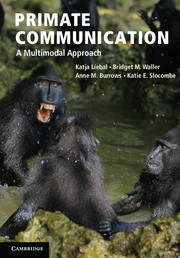Book contents
- Frontmatter
- Contents
- Preface
- Acknowledgements
- Part I Introduction to primate communication
- Part II Approaches to primate communication
- Part III Cognitive characteristics of primate communication
- 6 Acquisition
- 7 Flexibility
- 8 Intentionality
- 9 Referentiality
- Part IV Approaches to the evolution of primate communication
- Glossary
- References
- Species index
- Subject index
7 - Flexibility
Published online by Cambridge University Press: 05 December 2013
- Frontmatter
- Contents
- Preface
- Acknowledgements
- Part I Introduction to primate communication
- Part II Approaches to primate communication
- Part III Cognitive characteristics of primate communication
- 6 Acquisition
- 7 Flexibility
- 8 Intentionality
- 9 Referentiality
- Part IV Approaches to the evolution of primate communication
- Glossary
- References
- Species index
- Subject index
Summary
The previous chapter examined the generation of new signals, the modification of the structure of existing signals and acquisition of signals through development. This chapter will build on this previous discussion of ontogenetic flexibility and examine the extent to which existing signals can be used in different ways, combined into sequences and comprehended flexibly.
Why is it interesting to investigate flexibility?
Many very effective communicative displays in the animal kingdom are involuntary, inflexible, reflexive responses to specific stimuli. For instance, in response to a rapidly advancing predator, a moth will rapidly open its bottom wings to reveal two large, intimidating eye spots. This display is successful in deterring predators, but in the presence of the correct category of stimuli (any rapidly advancing object in this case) the moth will invariably give this response. Such automatic, reflexive, stimulus-response behaviour is very effective in many instances, but it is unlikely to require complex cognition and thus it tells us very little about the mental capacities of the animal producing the display. For instance, human pupils tend to dilate in response to attractive potential mates and this in turn makes the producer of this display appear more attractive: it is an effective display, but one not under the conscious or voluntary control of the producer. If looking for cognitively complex communication, such displays are not particularly informative. In contrast, in a flexible communication system where there is not a one-to-one correspondence between the stimulus and response, it is likely that more complex cognition is required to operate the system. Although it is difficult to elucidate the cognitive mechanisms underlying successful communication, attribution of cognitive processes can sometimes be the most parsimonious explanation for behaviour. Thus, where multiple signals and responses can be produced, it may be more parsimonious to assume that cognitive processes underlie the system, rather than a large number of automated responses. For these reasons, flexibility is often seen as a key hallmark of cognitive complexity in a communicative system.
- Type
- Chapter
- Information
- Primate CommunicationA Multimodal Approach, pp. 154 - 168Publisher: Cambridge University PressPrint publication year: 2013

